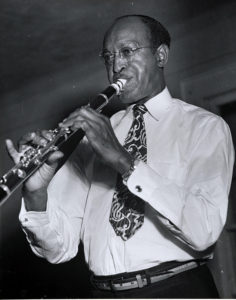Polo Barnes
New Orleans jazz clarinetist Paul “Polo” Barnes performed frequently at Preservation Hall in the 1960s.

Courtesy of Tulane University, William Ransom Hogan Archive of New Orleans Jazz
Paul 'Polo' Barnes playing the clarinet. Crawford, Ralston (Photographer)
Polo Barnes was an early New Orleans jazz multi-instrumentalist best known for playing the clarinet and alto saxophone. He was born into a highly respected musical family—his brother was noted ragtime and jazz clarinetist Emile Barnes—and began playing alto saxophone professionally while still in his teens. Considered one of the best (if not the best) saxophone players in New Orleans at the height of his career, Barnes performed with an unending list of jazz greats during his lifetime, including Oscar “Papa” Celestin, Joe “King” Oliver, and Jelly Roll Morton. In 1959 Barnes joined the New Orleans Ragtime Orchestra and was a member when that group made its influential 1960 recording for the Riverside record label’s Living Legends series. During the early years of his career, Barnes kept a diary on and off that would later give researchers much previously unknown information about music in New Orleans during the 1930s.
Paul Daniel “Polo” Barnes was born on November 22, 1902, in New Orleans. Older brother Emile gave Paul his first instrument, a toy fife. The young Paul soon graduated to clarinet, telling interviewers later on in his career that he made that choice because “little brothers want to do what big brothers do.” Barnes supplemented informal learning and self-teaching with more formal lessons at St. Paul’s Luther College, a higher-learning institution for black Lutherans. He first saw someone playing a saxophone at a circus and later claimed to reporters that he introduced saxophone playing to New Orleans jazz when he was seventeen or eighteen. Regardless, by all accounts he became a skilled saxophonist quickly enough that he was able to form his own group, the Original Diamond Orchestra, by 1919. This ensemble included his cousins––Cié Frazier (drums), Eddie Marrero (bass), and Lawrence Marrero (banjo)––along with Bush Hall (trumpet) and George Washington (trombone). Until 1922 Barnes was with Kid Rena’s popular band and played in the Maple Leaf Orchestra. In 1923 Paul joined perhaps the most popular New Orleans jazz ensemble of the time, Papa Celestin’s Original Tuxedo Orchestra, which would record Barnes’s original composition “My Josephine.”
Barnes played in Celestin’s orchestra until 1927, then joined King Oliver on tour in Chicago before coming on board with Jelly Roll Morton and his group, with whom Barnes recorded for the Victor record label in 1929. In 1932 Paul Barnes formed his own band, which included the renowned jazz pianist Nellie Lutcher. The year 1934 would see Barnes rejoining King Oliver on the road, though 1935 would see him back in New Orleans and collaborating with trumpeter Willie Pajeaud. The late 1930s would bring a partnership with Kid Howard.
During World War II Barnes played in a Navy band and attended the Navy Music School in Washington, D.C. After the war he rejoined Celestin’s Tuxedo Orchestra. He relocated to Los Angeles in 1951 and would remain there, playing for the Southern California Hot Jazz Society and others, for the better part of the 1950s. Barnes returned to New Orleans at the beginning of the 1960s, at which point he joined Paul Barbarin’s band. Brief tours during the early 1960s would take him away from New Orleans to play and record, but after 1964 he was a frequent performer at Preservation Hall, where he would continue to perform into the 1970s.
Barnes’s incomparable soprano saxophone solo on Jelly Roll Morton’s 1929 recording of Deep Creek Blues is usually considered by critics to be the recorded performance pinnacle of Barnes’s career.
Barnes died on April 3, 1981.
